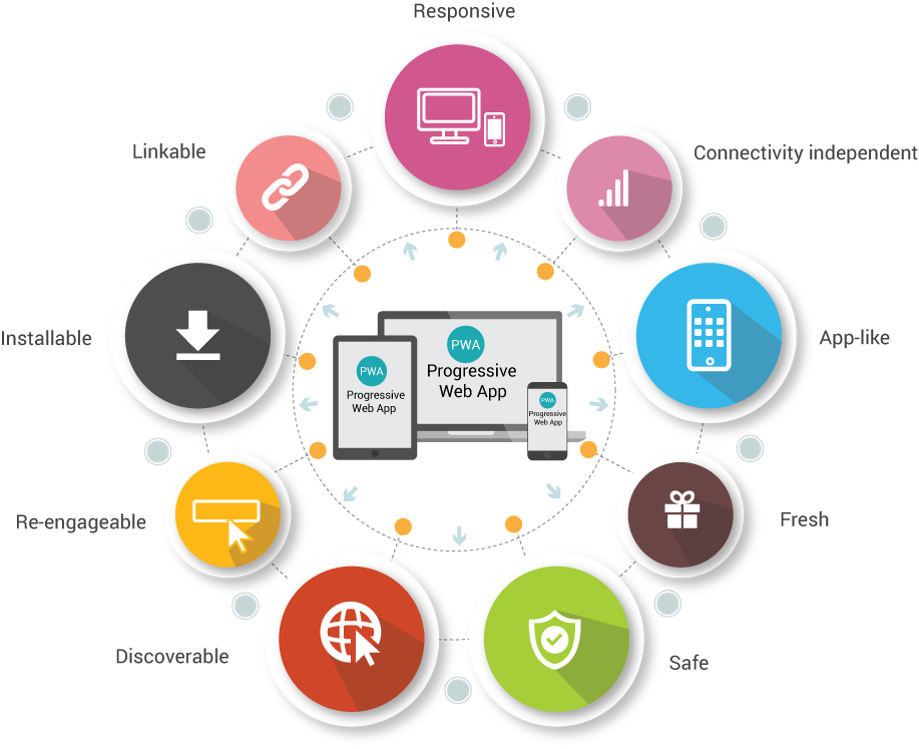Progressive Web Apps (PWA): The Future of Mobile Apps
With the rise of smartphones and mobile devices, businesses and developers are constantly looking for new and innovative ways to engage with users and provide a seamless mobile experience. One such technology that has gained popularity in recent years is Progressive Web Apps (PWA).
What are Progressive Web Apps?
Progressive Web Apps are web applications that provide an app-like experience to users, with features such as offline accessibility, push notifications, and full-screen mode. Unlike traditional mobile apps, PWAs can be accessed directly through a web browser without the need for installation from an app store. PWAs are designed to be fast, reliable, and responsive, providing a seamless user experience across different devices and platforms.

How do Progressive Web Apps work?
PWAs use modern web technologies such as service workers, web app manifests, and the web push API to deliver native-app-like functionality. Service workers enable PWAs to work offline and cache content, ensuring that users can access the app even when they are not connected to the internet. Web app manifests allow PWAs to be added to the home screen of a device and provide a native-like appearance, while the web push API allows PWAs to send push notifications to users.
Key Features of Progressive Web Apps
Here are the key features of Progressive Web Apps:

- Progressive: PWAs are designed to be progressive, meaning that they work for every user, regardless of the browser or device they use. They also adapt to the capabilities of the device, providing a seamless experience for all users.
- Responsive: PWAs are responsive, meaning that they work on any device, whether it is a desktop, tablet, or mobile device. They are also designed to fit any screen size, ensuring that the user interface is optimized for the device.
- App-Like: PWAs provide an app-like experience to users, with features such as push notifications, offline accessibility, and full-screen mode. They can also be added to the home screen of a device and launched like a native app.
- Connectivity Independent: PWAs can work offline and cache content, ensuring that users can access the app even when they are not connected to the internet. They can also use limited connectivity to provide a basic user experience.
- Safe: PWAs are designed to be secure, with features such as HTTPS encryption, ensuring that user data is protected. They also use web browser security measures to prevent attacks such as cross-site scripting and phishing.
- Discoverable: PWAs can be easily discovered by users through search engines and social media, as they use web technologies such as URLs and links.
- Installable: PWAs can be installed on the home screen of a device and launched like a native app, providing a seamless user experience.
- Linkable: PWAs can be shared easily through links, allowing users to share the app with friends and family.
- Fast: PWAs are designed to be fast, with features such as fast loading times and smooth animations, ensuring that users have a seamless experience.
- Engaging: PWAs offer features such as push notifications, full-screen mode, and offline accessibility, enhancing user engagement and driving customer loyalty.
Applications of Progressive Web Apps
Progressive Web Apps (PWAs) are web applications that are designed to provide users with an experience that is similar to that of native mobile apps. PWAs can be installed on a user’s device, work offline, and have access to devise hardware, making them a popular choice for many web developers. Some of the applications of PWAs include:
- Improved user experience: PWAs provide a seamless and responsive user experience, with features such as push notifications, offline capabilities, and the ability to access device hardware.
- Increased engagement: PWAs can be easily installed on a user’s device, which can help increase engagement and user retention. Additionally, features such as push notifications can help keep users engaged with the app.
- Faster load times: PWAs use a technique called caching, which allows them to load faster, even on slow or unreliable network connections.
- Cross-platform compatibility: PWAs are built using web technologies such as HTML, CSS, and JavaScript, which makes them platform-independent and able to run on any device with a modern browser.
- Lower development costs: Because PWAs use web technologies, they can be developed more quickly and at a lower cost than native mobile apps.
- Enhanced security: PWAs are served over HTTPS, which provides a secure connection and helps protect users’ data.
What are the benefits of Progressive Web Apps?
PWAs offer several benefits over traditional mobile apps. Firstly, PWAs are cost-effective, as they do not require the development of separate apps for different platforms. Secondly, PWAs are easy to deploy, as they can be updated instantly without going through the app store approval process. Thirdly, PWAs are cross-platform compatible, meaning that they work seamlessly across different devices and platforms.
Moreover, PWAs offer a seamless user experience with fast loading times and smooth animations. They also provide offline accessibility, allowing users to access the app even when they are not connected to the internet. Additionally, PWAs are highly engaging, with features such as push notifications and full-screen mode, which enhance user engagement and drive customer loyalty.
Conclusion
Progressive Web Apps are the future of mobile apps, providing a cost-effective, easy-to-deploy, and cross-platform compatible solution for businesses and developers. With the increasing popularity of PWAs, it is important for businesses to consider adopting this technology to provide a seamless mobile experience to their users. By leveraging the power of PWAs, businesses can engage with their users in new and innovative ways, driving customer loyalty and enhancing their brand image.

